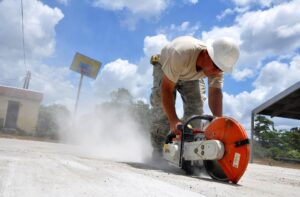
Three Common Problems with Concrete
As a concrete or construction pro, you’re likely familiar with all kinds of problems with concrete. And whether you’re called in to repair damaged or flaking material other companies have poured, or you’re interested in finding ways to avoid such troubles during your next job, it pays to understand the ins and outs of such issues. The General Chipping team has pulled together three common issues folks encounter when it comes to concrete — and a few preventative tips you should know.

Spalling
If you’ve ever seen a chunk of material crack off and tumble to the ground, you’ve seen spalling. This is one of the more dangerous problems with concrete, as that falling material can lead to serious damages and injury. It can also result in structural weakness, particularly if reinforcement bars are damaged. So, how does spalling happen?
When reinforcement bars are exposed to moisture — typically when the concrete cover on the bar is damaged — the steel oxidizes and forms rust. As the rust expands, it creates cracks inside the concrete (known as delamination) or from the bar to the exterior (spalling). When the cracks reach the surface, chunks of concrete are dislodged.
To help prevent spalling, make sure there are concrete covers around reinforcement bars. Covers can be damaged during installation, either by workers walking over them or by the force of the concrete when it’s poured, so educate crew members on the importance of cover integrity. Preventing moisture from getting to the steel is the only way to make sure spalling doesn’t become a problem down the road.
Flaking/Scaling
When concrete flakes off the surface, there’s a good chance it wasn’t mixed or installed correctly. Scaling, or flaking, happens when concrete freezes and thaws multiple times within a season and the concrete mix wasn’t prepared to meet this stress. It also occurs when the water in the concrete wasn’t allowed to evaporate completely before final finishing.
While scaling isn’t usually as dangerous as spalling, it can present trip hazards if it’s on the ground. It can also degrade quickly. There are a couple of ways to prevent scaling. Add air entrainment compounds to help prevent it from occurring during freeze and thaw cycles, and ensure the water within your concrete evaporates completely before final finishing.
General Cracking
There are many reasons concrete will crack, and not all of them are dangerous or even need to be repaired. In fact, cracking is a normal part of everyday wear and tear. However, improper installation will create larger cracking problems that shorten the life of the project.
Too much water in the mix will create “plastic shrinkage” cracks. As the water evaporates during the plastic phase, too much space is left behind and the concrete cracks. Usually these cracks are small, but they’ll travel through the entire slab. Always ensure you’re using the right amount of water for your mix to prevent such damage.
On the other end of the spectrum, concrete that is too dry will also crack. These are called “crazing cracks” and can look like a spider web or shattered glass. While crazing is unattractive, it’s usually only surface cracking and shouldn’t present any structural damage.
Have questions about concrete work, or need help drum maintenance? Give General Chipping a call. We’ve been working with concrete pros since 2007, and we’re experts when it comes to concrete chipping, central mixer cleaning and cement silo cleaning services.
